- Open today, noon to 5 pm.
- Parking & Directions
- Free Admission
Meeting Nancy Hungerford
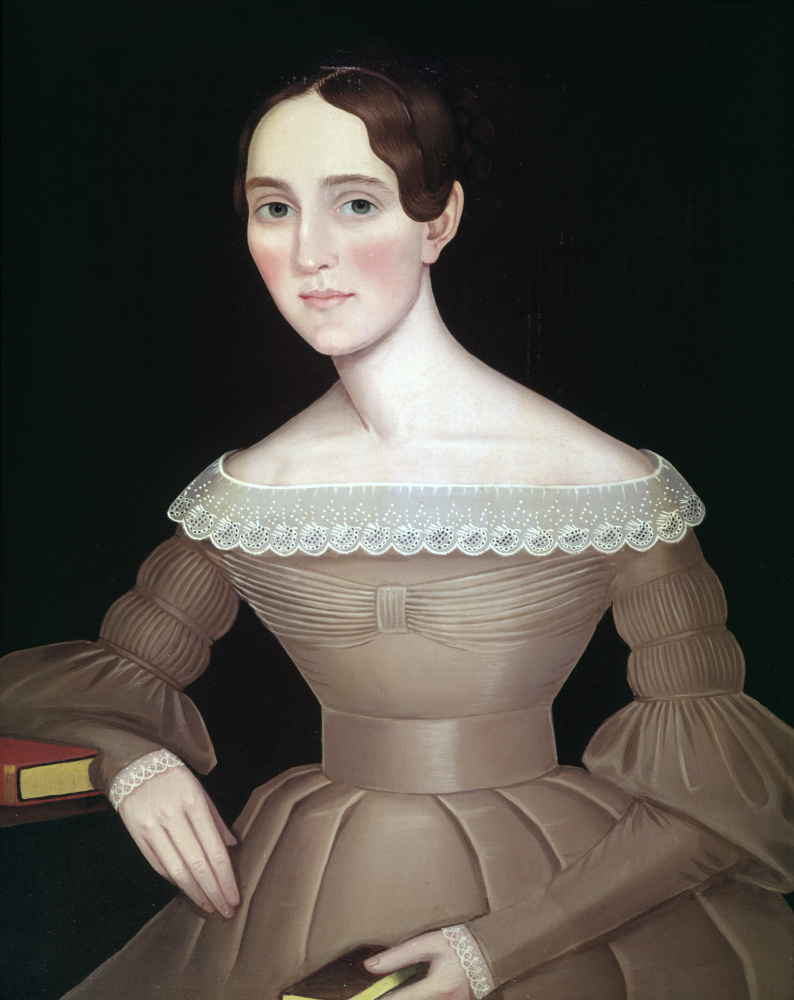
Ammi Phillips (American, 1788—1865), Nancy Hungerford, ca. 1838, Oil on canvas, Gift of Edgar William and Bernice Chrysler Garbisch, 74.6.13
Today’s culture of modernism is all but overwhelmed by visual imagery. Carrying photo technology with us at all times, we take and share all manner of pictures using devices that improve at ever-escalating speed. In this world flooded with visual depictions, what does it take to make us stop and engage with one singular image? What drew me to stop and spend time with this portrait of Nancy Hungerford?
When I walk through the galleries of the Chrysler Museum of Art, I see varied images of women from multiple periods of art. In many, I see aspects of being a woman, but seldom do I find the spare fullness of being that I see in Ammi Phillips’s Nancy Hungerford. What have other artists missed, ignored, or thought of lesser importance that Phillips, a self-taught painter from American’s early provincial villages, offers to us in our so-proudly modern time? Looking at and comparing other works may suggest what I find special about Nancy Hungerford.
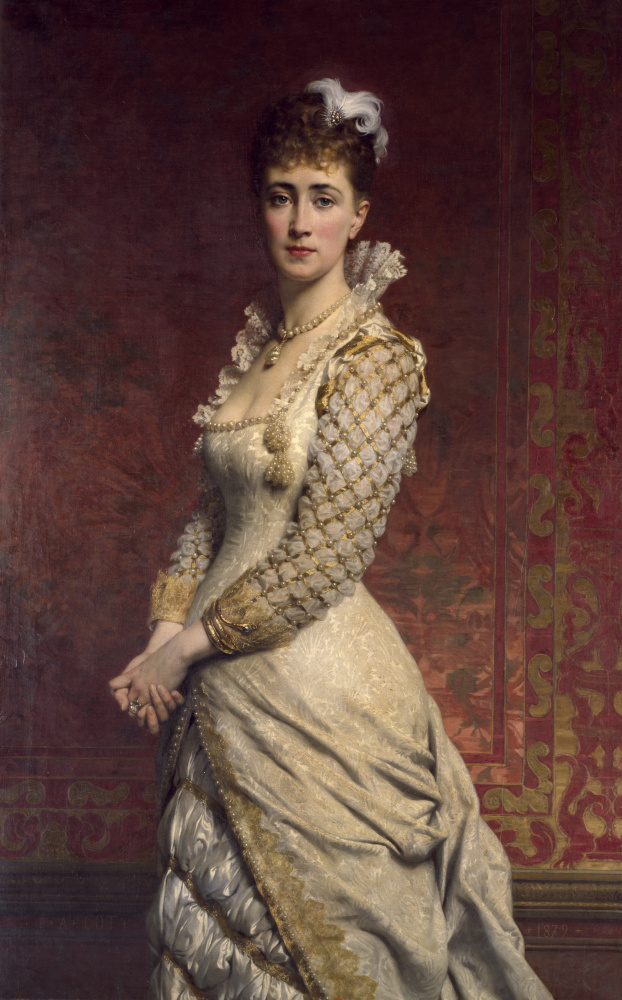
Pierre-Auguste Cot (French, 1837–1883), Portrait of a Lady (Mme H.S.), 1879, Oil on canvas, Gift of Walter P. Chrysler, Jr., 71.2068
Some, like Pierre August Cot’s Portrait of a Lady (1879) make an upfront, immediate declaration of proud materialism. People are what they wear. While we stand in awe of the rich, pearl-encrusted dress and the textures portrayed, they are everything Puritan culture would decry. God-centered simplicity is replaced by earth-made things that declare a person’s value in terms of wealth. The woman (notice the title forgoes even naming her) seems almost lost under and amid grandeur. Is the feather headdress a subtle reference to her state of mind? Is she, like her jewels, an ornament? Is she playing a role, helping elevate a man’s status in society by wearing and exhibiting his wealth? Apart from her richly detailed dress and elegant background, I see emptiness where I want to meet a woman.
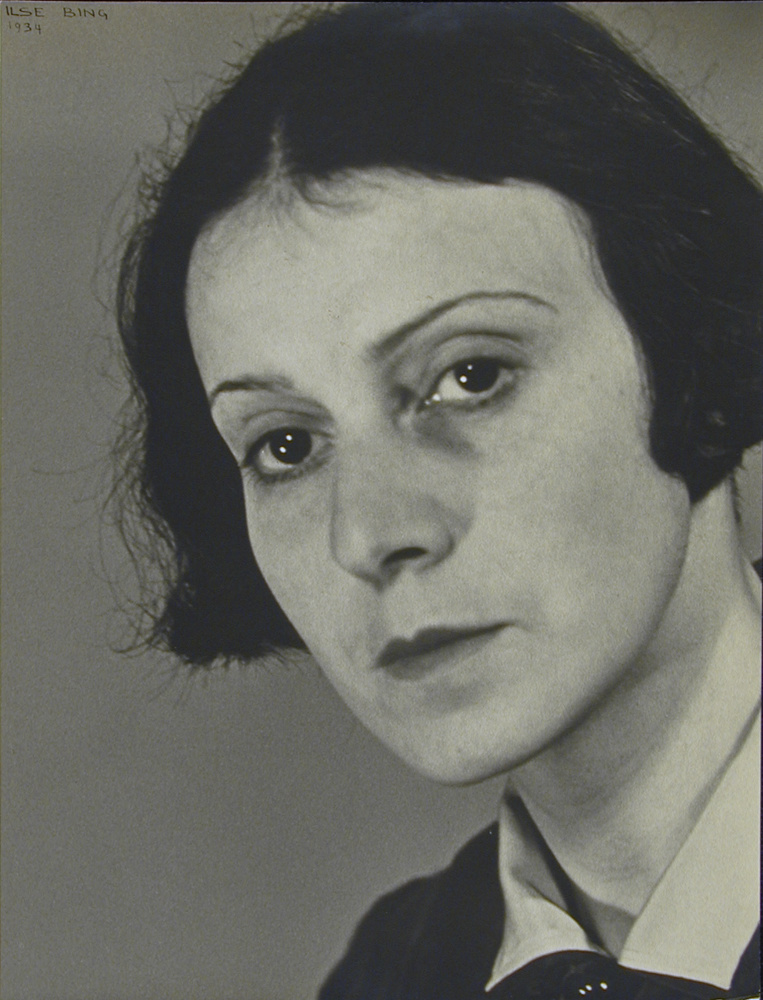
Ilse Bing (American, b. Germany, 1899–1998), Portrait of a Woman, 1934, Gelatin-silver print, Gift of the Ilse Bing Estate, 2004.13.37
In the photographic self-portrait Portrait of a Woman (1934) taken by Ilse Bing, I find immediate comparisons to Nancy Hungerford’s portrait. The background, though much lighter, is plain and solid. Each quiet woman is alone in her picture. Like Nancy Hungerford, Bing leans her head and has severely styled dark hair parted in the middle. Differences arise with the modernity of photography and continue with the short-haired forcefulness of a woman so intensely immediate to us. We see a closed collar and small portion of a darker buttoned garment. None of the choices Bing makes soften her or make her friendly. The sitter’s eyes look outward, yet they do not. Her left eye in particular seems to be looking past the viewer. Her expression feels closed. We cannot be sure what might engage the subject, but sense that it is not us. Meditative or self-absorbed, she does not appear welcoming, and I sense that she may be a woman easier to admire than to enjoy.

American Art Galleries. American Art in the Folk Tradition. Gallery 210.
Through Ammi Phillips’s painted portrait of Nancy Hungerford, the sitter shares with us… herself. Silently, Nancy allows us to enter her world—that of a young woman, likely of comfortable means, in 1838 Colebrook, Connecticut. Both Nancy’s confident look and the spare style of this work strike me as harmonious precursors to life and art of modern times.
The minimalism of Phillips’s artistic style resonates with twenty-first-century eyes and sensibility. We see crisp outlines and unmodulated blocks of colors.1 While there is some slight shading, the straightforward emphasis is on line and color. We are not distracted by extraneous items; Phillips offers only Nancy, her dress, two books, and a table all unseen except for the closed book whose red color calls attention to its resting place. There are no additional objects that indicate where she sits, the time of day, or her role in life. The artist’s solid dark background is void of architectural features, and there is no additional furniture; even the object we assume she must be sitting on is not shown.

Ammi Phillips (American, 1788—1865), Nancy Hungerford, ca. 1838, Oil on canvas, Gift of Edgar William and Bernice Chrysler Garbisch, 74.6.13
Nancy Hungerford is a woman well above a laboring class. She is a reader with time and money for books. Although she does not wear jewelry, her class status is apparent in her softly structured, pleated gold-tan dress made of rich-looking polished fabric trimmed with lace. While there is nothing flamboyant—no gold buttons or grand ostentation—her attire seems appropriate for a social occasion. I can only imagine her party shoes that we cannot see.
In American Naïve Painting of the 18th and 19th Centuries, Albert Ten Eyck Gardner, Associate Curator of Paintings and Sculpture in the American Art Dept. of the Metropolitan Museum of Art from 1956–1967, wrote that although “there were more artisans and amateur painters … in provincial America in the seventeenth and eighteenth centuries than is generally supposed, the great burgeoning of naïve art did not occur until after the American Revolution and it came to its fullest development in the first half of the nineteenth century.”2 During that time, the rural north experienced a new age of abundance and with it “a greater desire for display and a confirmation of taste.”3 With family portraits, upper- or middle-class villagers were able to combine their desire for creating a family record with embellishing and decorating their homes in one of the few ways permissible in a region whose culture still strongly reflected Puritan values of simplicity and restraint.4
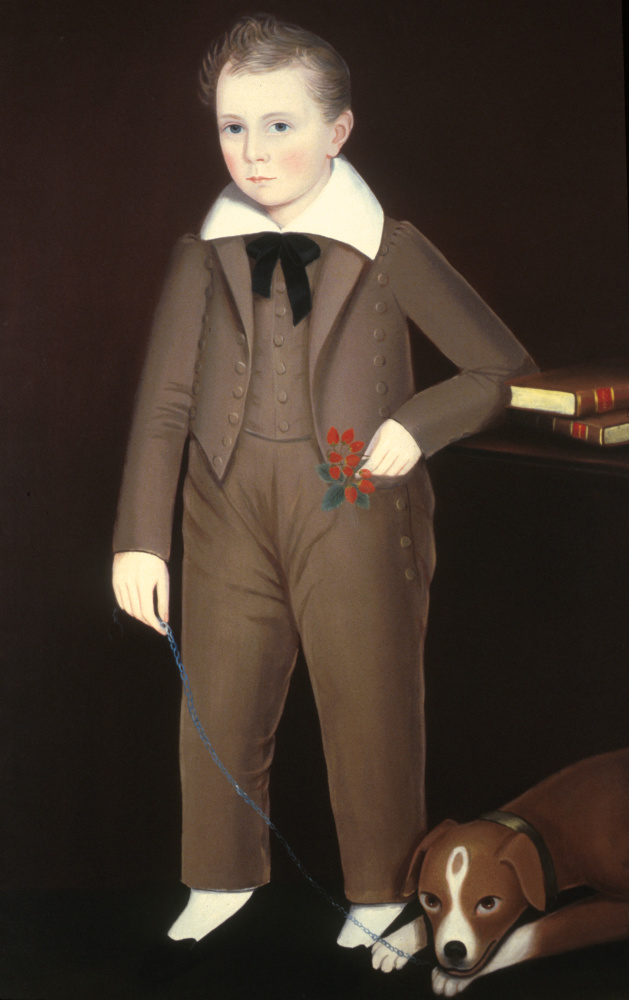
Ammi Phillips (American, 1788–1865), John Younie Luyster, ca. 1838, Oil on canvas, Gift of Edgar William and Bernice Chrysler Garbisch, 74.6.4
It was during this time that Ammi Phillips (pronounced Am-eye according to the New England Historical Society) began painting portraits. He entered this realm of artistry in 1809. By the mid-1820s to 1830s, his work showed “greater realism, deeper coloring … [and] new interest in costume.”5 Kelli Stewart notes that Phillips’s portraits of the 1830s “display … confidence and control, … solidity of shape and color, … drama in the dark background.” His backgrounds, she says, were unlike “more elaborate sets used by contemporaries and drew strong, immediate focus to his sitters’ faces.”6 Others also note that line and color are characteristics of Phillips’s work, his sharply contrasting light and dark elements creating images that call to us as true portraits and not just subjects with flat heads and generic human features.
Like Nancy Hungerford, Phillips (1788–1865) was born in Colebrook7, Connecticut. Indeed, Nancy may have been a relative of his sister-in-law.8 Colebrook, like most American towns outside major cities, was too small to support a permanent portrait artist. In these small communities, Phillips would settle in, advertise, and paint portraits. Then he would move on in search of more commissions.9 Likely self-taught, he developed a style of straightforward simplicity.
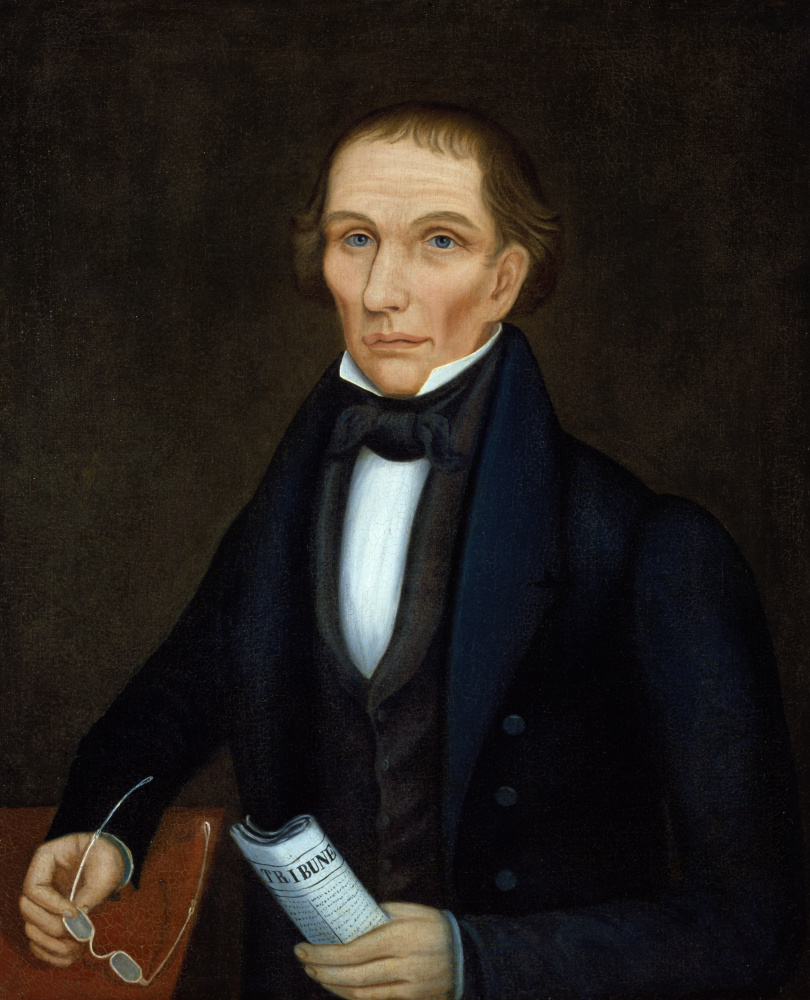
Ammi Phillips (American, 1788–1865), Nicholas Mundy, 1852, Oil on canvas, Gift of Edgar William and Bernice Chrysler Garbisch, 78.633.9
His style was well suited to the people and culture of his time and place. Early settlement by Puritans had created a society that valued simplicity. The people avoided showy materialism or bringing excess attention to themselves or their belongings. Complex people and the societies they created brought countering impulses. Some believed that using gifts that God blessed them with and working with God-inspired diligence resulted in wealth and abundance. Proving that they had worked under God’s direction and had been rewarded for that could be seen as a religious act. Acknowledging God’s righteous blessings along with the human urge to put their best foot forward, sitters surely appreciated being shown in portraits dressed in quietly rich garments. The attire was often provided by portrait artists like Phillips, the likely owner of the dress we see on Nancy Hungerford. After all, Phillips promised in his ads to paint customers in up-to-date fashions.
Several artists portray women who, at first glance, offer what I find in Nancy Hungerford by Ammi Phillips but ultimately do not. The works are not lesser; each artist presents a different vision of being a woman. All of the sitters are silent (mouths closed), fairly young in age, and in the foreground. What is special about Nancy? I see assured openness. She appears ready to be with us and accept us into her world. Though earlier absorbed in her book, she now offers herself to us and allows us to engage. With upright, confident posture, she looks straight forward; I sense that this woman could be comfortable entering our own world. In fact, “comfortable” may be a very good description of Nancy Hungerford as painted by Ammi Phillips. Both her portrayed character and the minimalistic artistry of Phillips, with its blocks of color and immediacy of subject, seem very much at home in today’s (art) world.
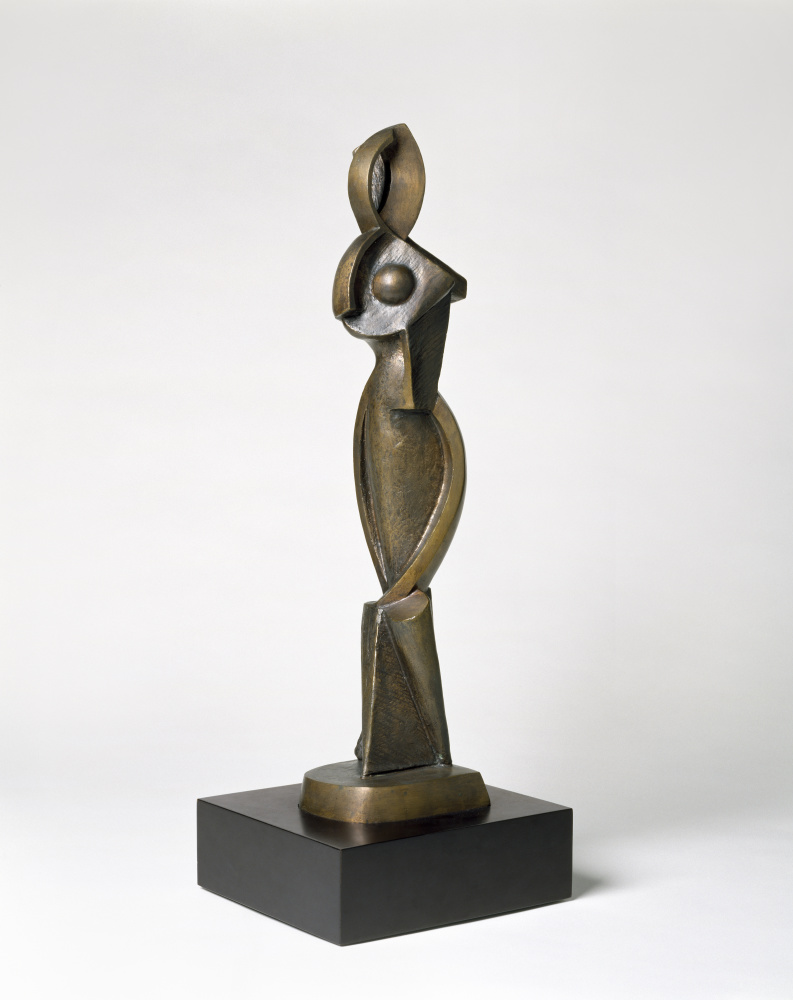
Alexander Archipenko (Ukrainian, 1887–1964), Geometric Figure No. 1, 1914, Bronze, Gift of Walter P. Chrysler, Jr., 71.2071
I carry thoughts of Nancy Hungerford’s portrait with me along with another favorite Chrysler piece, Alexander Archipenko’s (Ukrainian/American) bronze sculpture, Geometric Figure No. 1 (1914). Its feminine lines and curves and strong, vertically confident, smooth, and textured surfaces offer complex simplicity. It offers a modern Cubist interpretation of what Phillips may have sought in his earlier portrait of his subject. In both works, I see the simplicity of a single subject without extraneous distraction. In paint and bronze, I see artists exploring and interpreting self-assured femininity with line, shape, and form. Nancy, who lived in a time when women’s lives and identity were largely pre-determined by social restrictions and rules, is presented as an individual. Archipenko’s later sculpture, completed when I believe women had at least a glimmer of more independence and freedom to be themselves, offers, by contrast, a work exploring not a singular, unique female but an unidentifiable, representational “woman.” The works merit continued conversation.
–Maureen S. Harms, Chrysler Museum Docent
Footnotes
- Haygood and Harrison, American Art at the Chrysler Museum, 42.
- Gardner, American Naïve Painting of the 18th and 19th Centuries, 19.
- Jaffee, “A Correct Likeness,” 125-126.
- Jaffee, “A Correct Likeness,” 111-112.
- Ammi Phillips, National Gallery of Art Web Site as of March 18, 2018.
- Stewart, Kelli, Ammi Phillips, Skinner Auctioneers and Appraisers Web Site posted February 22, 2013, Viewed March 18, 2018.
- National Gallery of Art Web Site as of March 28, 2018.
- Ammi Phillips, Chrysler Museum of Art Web Site as of March 18, 2018
- Metropolitan Museum of Art Web Site as of March 28, 2018.
Bibliography
Chrysler Museum of Art’s Web Site. As of March 16, 2018.
Colebrook Connecticut’s Web Site. As of March 16, 2018.
Gardner, Albert Ten Eyck. Introduction to American Naïve Painting of the 18th and 19th Centuries. New York: R.R. Donnelley and Sons Company, 1969.
Haygood, Martha N. and Jefferson C. Harrison. American Art at the Chrysler Museum. Norfolk, Virginia: The Chrysler Museum, 2005.
Jaffee, David. “A Correct Likeness: Culture and Commerce in Nineteenth-Century rural America” in Reading American Art edited by Marianne Doezema and Elizabeth Milroy. New Haven and London: Yale University Press, 1998.
Johnson, Ken. Review of Mark Rothko and Ammi Phillips exhibition, Art and Design, October 26, 2008. New York Times Web Site. Viewed March 18, 2018.
Metropolitan Museum of Art’s Web Site. As of March 18, 2018.
National Gallery of Art’s Web Site. As of March 16, 2018.
New England Historical Society’s Web Site. As of March 18, 2018.
Prown, Jules David. American Painting from Its Beginnings to the Armory Show. Cleveland, Ohio: The World Publishing Company, no publishing date given but purchase documented as 1971.
“Self-Taught Genius.org”, Treasures from the American Folk Art Museum [Show] May 13, 2014 – January 8, 2017. Viewed March 18, 2018.
Skinner Auctioneer and Appraiser’s Web Site. Posted February 22, 2013 by Kelli Stewart, viewed March 18, 2018.

